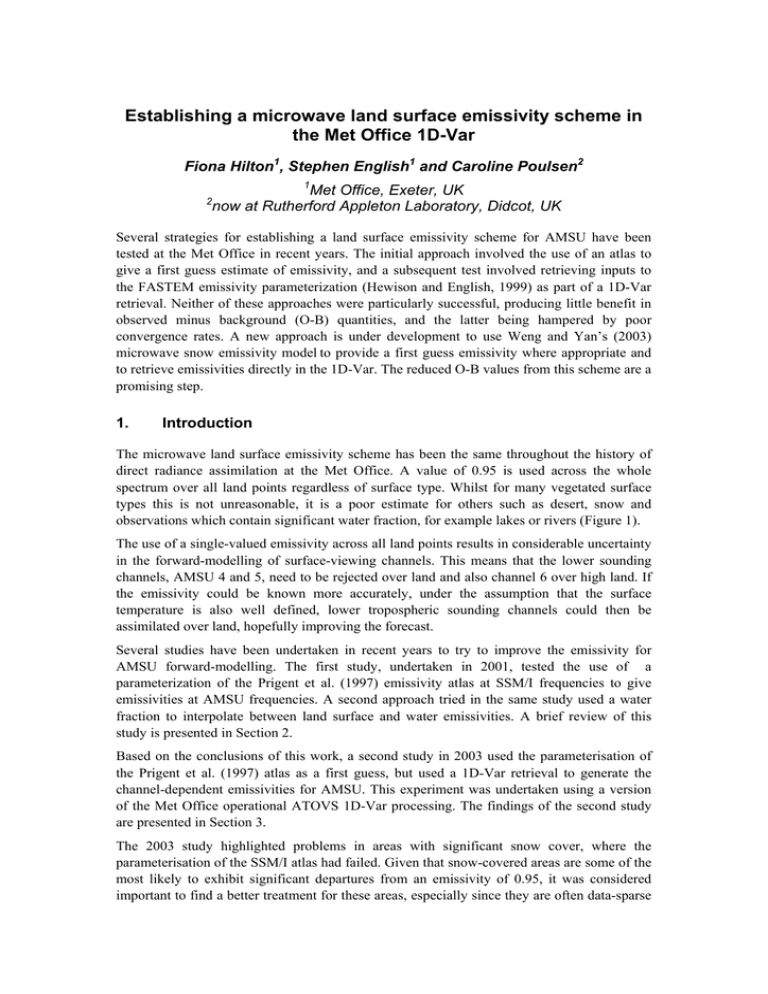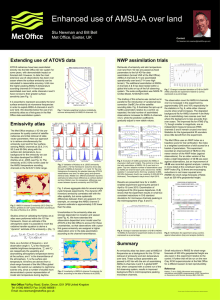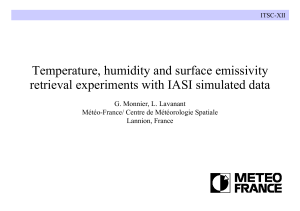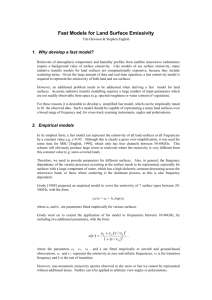Establishing a microwave land surface emissivity scheme in Fiona Hilton
advertisement

Establishing a microwave land surface emissivity scheme in the Met Office 1D-Var Fiona Hilton1, Stephen English1 and Caroline Poulsen2 1 2 Met Office, Exeter, UK now at Rutherford Appleton Laboratory, Didcot, UK Several strategies for establishing a land surface emissivity scheme for AMSU have been tested at the Met Office in recent years. The initial approach involved the use of an atlas to give a first guess estimate of emissivity, and a subsequent test involved retrieving inputs to the FASTEM emissivity parameterization (Hewison and English, 1999) as part of a 1D-Var retrieval. Neither of these approaches were particularly successful, producing little benefit in observed minus background (O-B) quantities, and the latter being hampered by poor convergence rates. A new approach is under development to use Weng and Yan’s (2003) microwave snow emissivity model to provide a first guess emissivity where appropriate and to retrieve emissivities directly in the 1D-Var. The reduced O-B values from this scheme are a promising step. 1. Introduction The microwave land surface emissivity scheme has been the same throughout the history of direct radiance assimilation at the Met Office. A value of 0.95 is used across the whole spectrum over all land points regardless of surface type. Whilst for many vegetated surface types this is not unreasonable, it is a poor estimate for others such as desert, snow and observations which contain significant water fraction, for example lakes or rivers (Figure 1). The use of a single-valued emissivity across all land points results in considerable uncertainty in the forward-modelling of surface-viewing channels. This means that the lower sounding channels, AMSU 4 and 5, need to be rejected over land and also channel 6 over high land. If the emissivity could be known more accurately, under the assumption that the surface temperature is also well defined, lower tropospheric sounding channels could then be assimilated over land, hopefully improving the forecast. Several studies have been undertaken in recent years to try to improve the emissivity for AMSU forward-modelling. The first study, undertaken in 2001, tested the use of a parameterization of the Prigent et al. (1997) emissivity atlas at SSM/I frequencies to give emissivities at AMSU frequencies. A second approach tried in the same study used a water fraction to interpolate between land surface and water emissivities. A brief review of this study is presented in Section 2. Based on the conclusions of this work, a second study in 2003 used the parameterisation of the Prigent et al. (1997) atlas as a first guess, but used a 1D-Var retrieval to generate the channel-dependent emissivities for AMSU. This experiment was undertaken using a version of the Met Office operational ATOVS 1D-Var processing. The findings of the second study are presented in Section 3. The 2003 study highlighted problems in areas with significant snow cover, where the parameterisation of the SSM/I atlas had failed. Given that snow-covered areas are some of the most likely to exhibit significant departures from an emissivity of 0.95, it was considered important to find a better treatment for these areas, especially since they are often data-sparse in terms of conventional observations (e.g. Siberia and Antarctica). Following promising results with Weng and Yan’s (2003) snow emissivity model, (hereafter referred to as SnowEM) a third approach was considered. SnowEM would provide a first guess emissivity which could be used in the 1D-Var retrieval scheme. Figure 1: Nadir emissivity spectra from FASTEM2. Parameters for the model are taken from Hewison and English (2000) and correspond to classes from Hewison’s airborne campaign, except Desert for which the parameters are based on the Prigent et al. (1997) SSM/I atlas. At the present time, it has not been possible to implement the 1D-Var retrieval of channeldependent emissivity. However, Section 4 discusses the findings of a preliminary study using SnowEM to provide the emissivity for all AMSU observations where the Met Office Unified Model (UM) predicts snow cover, without performing the subsequent emissivity retrieval. 2. AMSU emissivity from an emissivity atlas In the first study, the Prigent et al. (1997) emissivity atlas at SSM/I frequencies was converted into a set of five parameters which describe the spectral variability of the emissivity for each point in the atlas. These parameters represent static permittivity, infinite permittivity, relaxation frequency, small-scale roughness and large-scale depolarisation. They can be used with the FASTEM land emissivity module (Hewison and English, 1999), part of the RTTOV 1 radiative transfer code which is used operationally in forward-modelling of satellite radiances for assimilation at the Met Office. The conversion of the atlas was not perfect: in some locations, notably over snow though not restricted to snowy areas, the code used to fit the five parameters to the data failed to converge on a solution, leaving gaps in the new atlas (Figure 2). 1 RTTOV: http://www.metoffice.com/research/interproj/nwpsaf/rtm/index.html Figure 2: Location of points in the SSM/I emissivity atlas for January. Note gaps over Canada and Siberia Brightness temperatures were forward-modelled using a Met Office NWP Analysis field together with a pre-release version of RTTOV7 and the emissivity parameters from the atlas. These forward-modelled values were compared with collocated AMSU observations. Figure 3 shows a map of the O-B values for AMSU Channel 4. Coastal areas and points around lake and river edges were poorly fit as were desert areas. A second approach to land emissivity modelling was also tried in the same study. The International Geosphere Biosphere Project (IGBP) Land Classification atlas (Belward, 1996) was regridded to the AMSU field of view using optimal convolution (Bennartz,2000) to give a percentage of each footprint covered by water and by land. The emissivity was then calculated using the following formula: Emissivity = Land Fraction * 0.95 + Water Fraction * Water Emissivity FASTEM was used with the collocated NWP information to calculate the emissivity of water for each location. Clearly this approach will only be useful where the water fraction for the observation is greater than zero. Figure 4 shows histograms of the O-B values, demonstrating that where the water fraction is greater than zero, the land/water fraction approach gives a much better fit to AMSU Channel 4 than the operational scheme and the emissivity atlas as expected. However, disappointingly, for vegetated classes, we did not find any improvement in the fit to AMSU observations with either the emissivity atlas approach or the water fraction method. Figure 3: AMSU Channel 4 O-B values for the parameterized SSM/I emissivity atlas method The conclusion from the study was that whilst the land/water fraction approach might be beneficial, the computer time required to regrid the surface type atlas to the observations was prohibitive. The land atlas approach was deemed to provide insufficient improvement in O-B values to be used on its own to estimate emissivity. The recommendation of the study was to use the emissivity from the atlas as a first guess for input into a 1D-Var retrieval scheme, to allow the observations and knowledge of the surface temperature to influence the emissivity. Figure 4: O-B distrubutions for three emissivity schemes: black=operational, blue=SSM/I atlas, red=water fraction. Left: water fraction >0; Right: Evergreen Needle Leaf Forest 3. 1D-Var emissivity retrieval using an atlas as first guess The second study, carried out in 2003, attempted to implement the 1D-Var approach using the parameterised atlas (as above) to generate first guess emissivities. Testing was carried out using a modified version of the operational Met Office 1D-Var system. AMSU window and lower sounding channels (1, 2 and 3; 4 and 5) were used for the first time in the 1D-Var in order to constrain the emissivity. The intention was then to use AMSU 4 upwards for assimilation in 3D-Var with the retrieved emissivity. RTTOV K code outputs brightness temperature gradients with respect to the emissivity parameters provided and it was therefore decided to retrieve, not the spectrum of emissivity itself, but values of the parameters. These would be converted into spectral emissivity before 3D-Var. The five parameters were added to the 1D-Var control vector and were assumed to be independent of the other atmospheric variables included for retrieval. Examination of the O-B values for this scheme (Figure 5) confirmed the 2001 results: there was very little change in the distribution across a wide number of observations compared with using a flat 0.95 emissivity for all frequencies. There was improvement in the distribution of observed minus retrieved (O-R) values, feeding up as far as Channel 5 (Figure 6). Unfortunately the gains in O-R accuracy came at the cost of worsening performance of the 1D-Var scheme. Using existing quality control and cloud tests, 2.5 times more observations were rejected over land than previously, mostly because the 1D-Var failed to converge on a solution. The new emissivity scheme was initially only implemented for clear observations so the actual number of observations with the retrieved emissivities accepted was very small: less than 2% of the data with this set up. Thus a small gain in the number of AMSU 4 and 5 observations passing quality control was offset by a large loss in the number of tropospheric sounding channels passed to 3D-Var. Successful minimisation during the 1D-Var was also a problem. In operational runs, the convergence criteria applied in the 1D-Var minimisation requires only two expensive RTTOVK calculations to be performed for most observations. The new scheme increased the average number of iterations needed over land for the observations which did converge on a solution. It was found that several factors influenced the poor convergence. One was the background error variances assumed for the emissivity parameters. Making sure these values were not too large helped to improve the convergence statistics, but the values were only chosen by trial and error since there was no rigorous means available to estimate the error on the parameters. Problems still remained with parameter values going negative (unphysical) during minimisation, which would have required further investigation if this approach had been studied further. Secondly, quality control checks were rejecting the surface-viewing channels in many instances leading to an attempt to retrieve emissivity values with no information from the brightness temperatures. Once this was discovered, the quality control checks were altered, allowing all channels to be included most of the time. This is beneficial from the point of view of retrieving emissivities for points where emissivity parameters were present, but on the other hand, resulted in additional, costly radiative transfer calculations in instances where channels should normally have been rejected. Figure 5: Histograms red=emissivity atlas of O-B for Figure 6: Histograms of O-R for (emissivity=0.95), green=emissivity atlas AMSU1-6. AMSU1-6 Black=operations for snow points. (emissivity=0.95), Black=operations Switching off the quality control on the surface channel and allowing the same channels to be used in cloudy cases as well as clear air eventually produced a 49% rejection rate for the new scheme as opposed to 40% for a control run which kept the cloud type-dependent channel selection. The minimization was also much improved, with 90% of observations requiring only two RTTOVK calls. Despite these more promising results, reducing the quality control on the observations without additional investigations into the data quality meant that the scheme could not be implemented. The struggle to achieve convergence and the lack of improvement in O-B values suggested that the emissivity atlas as defined was not providing a good enough first guess to make it worth using within the context of the Met Office 1D-Var scheme. It should be noted that there now exists an emissivity atlas derived directly from AMSU observations and at AMSU frequencies, in Karbou et al. (2005). The emissivities resulting from the parameterisation of the SSMI atlas have not been compared with the AMSU atlas to see whether any significant differences have resulted from the parameterisation. 4. A snow emissivity scheme for AMSU A further problem shown in the 2003 study was the lack of emissivity parameters in snowcovered areas. It was therefore decided to develop a way of providing a first guess emissivity for observations where the UM snow diagnostic field showed that the point was snowy (>0.125kg/m2), as a priority over areas where the 0.95 emissivity was more applicable. Weng and Yan’s (2003) SnowEM was chosen to provide the first guess emissivity. This model is an empirical scheme, taking AMSU window channel brightness temperatures and a skin temperature, and fitting to them one of sixteen different snow type reference emissivity profiles. Emissivities at the intermediate frequencies are then interpolated from the reference profile and the 183.3GHz emissivities are extrapolated. The advantage of using this scheme to provide a first guess emissivity is that the scheme is empirical and based on the observations themselves. It should therefore be an input for the minimisation scheme closer to the 1D-Var solution than the emissivity from the atlas as used in previous studies, assuming an accurate skin temperature was also provided to the model. Thus far, technical problems with the implementation have prevented investigations into the use of SnowEM to provide a first guess for a 1D-Var minimisation. However, some initial tests were carried out to see whether the emissivities did indeed provide a better first guess by investigating the O-B distribution for snow points. It should be mentioned that the UM snow diagnostic is not an operationally produced field and investigations have shown significant discrepancies between it and the NESDIS Interactive Multi-Sensor Snow and Ice Mapping System (Cameron, 2004). Despite uncertainty in the accuracy of the snow field, in contrast to the previous studies with the emissivity atlas, SnowEM does indeed improve the standard deviation of O-B for the window and lower sounding channels (Figure 7). This is a very encouraging result, and in particular may allow us to use more data in the future over Siberia, Greenland and Antarctica. Figure 7: Histograms of O-B for AMSU1-6 for snow points. Red=operations (emissivity=0.95), black=SnowEM SnowEM also produces a snow-type classification for each observation. A surprising result for the test case studied was that over 80% of observations failed to fit any of the first 15 reference snow profiles and were therefore assigned, by default, the emissivity spectrum of snow type 16, “Thick crust snow” (Figure 8). This is not the expected result (Weng, pers. comm.). It is possible that this result could have arisen through discrepancies in the bias correction of the AMSU window channels. It is interesting that even though the classification seems to be wrong, a good first guess of O-B has resulted in the majority of snow cases. Figure 8: SnowEm Snowtype classification of AMSU observations from a study of six hours of ATOVS observations in the Met Office 1D-Var scheme. Yellow=‘Thick Crust Snow’ 5. Conlcusions In an attempt to improve land surface emissivity within the Met Office 1D-Var, with the aim of assimilating AMSU channels 4 and 5 over land, three studies have been carried out in recent years. The first and second studies involved the use of an atlas of emissivity parameters, which failed to provide a good enough estimate of emissivity to use without any additional information from the observations themselves. An attempt to add the emissivity parameters to the 1D-Var control vector was hampered by poor convergence statistics. One of the main drawbacks of the atlas is providing an appropriate emissivity estimate in snow-covered areas. Recent work has focussed on the use of Weng and Yan’s (2003) SnowEM to provide a first guess in snowy areas. Although this work is incomplete, the improvements seen in O-B values for these points are very encouraging and may help to enable the assimilation of more AMSU data over data-sparse land areas in the future. However, concerns over the quality of the surface temperature field will need to be addressed before significant progress can be made. 6. References Belward, A.S., Estes, J.E., and Kline, K.D., 1999: The IGBP-DIS 1-Km Land-Cover Data Set DISCover: A Project Overview. Photogrammetric Engineering and Remote Sensing, v.65, p.1013-1020 Bennartz, R., 2000: Optimal convolution of AMSU-B to AMSU-A. Journal of Atmospheric and Oceanic Technology, v. 17, p.1215-1225 Cameron, J.R.N., 2004: Comparison of Unified Model Snow and Sea-Ice Fields with NESDIS and USAF Data Sets. Met Office Forecasing Research Technical Report No.416 Hewison, T.J. and English, S., 1999: Airborne retrievals of snow and ice surface emissivity at millimeter wavelengths. IEEE Transactions in Geoscience and Remote Sensing, v.37, p.1871–1879 Hewison, T. and English, S., 2000: Fast models for land surface emissivity. In: Cost Action 712 — Radiative transfer models for microwave radiometry Final Report of Project 1, ed. Matzler, C, published by the European Commission, EUR19543EN, p.117–127 Karbou, F., Prigent,C., Eymard, L., and Pardo, J., 2005. Microwave land emissivity calculations using AMSU measurements, IEEE Transactions in Geoscience and Remote Sensing, v.43, p. 948- 959. Prigent C., Rossow, W.B. and Matthews, E., 1997: Microwave land surface emissivities estimated from SSM/I observations. Journal of Geophysical Research, v.102, p.21867–21890 Weng, F. and Yan, B., 2003: A microwave snow emissivity model. In: Proceedings of the Thirteenth International TOVS Study Conference; Sainte Adèle, Canada, 29 October – 4 November 2003; ed. Saunders, R. and Achtor, T; http://cimss.ssec.wisc.edu/itwg/itsc/itsc13/proceedings/session4/4_3_weng.pdf




